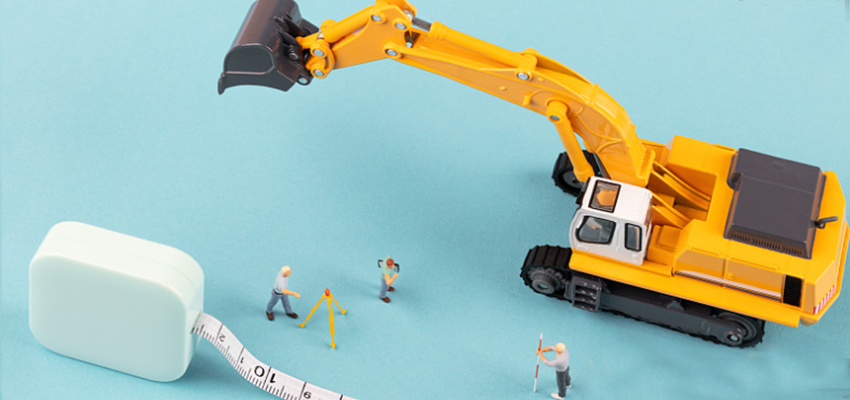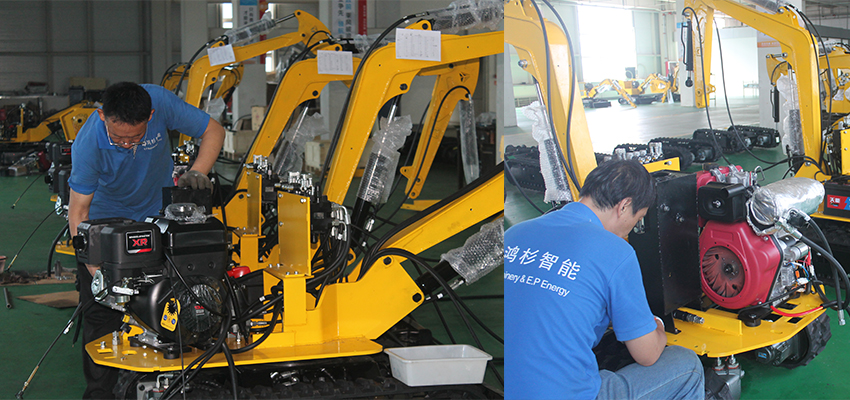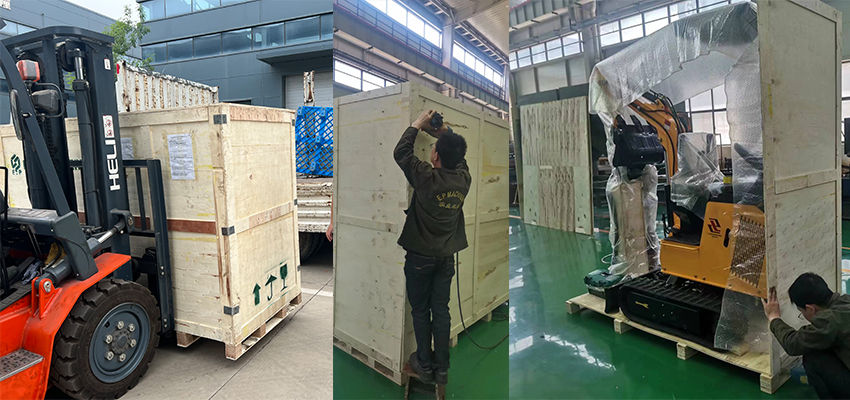E.P machinery company Mini Digger, Mini Excavator Factory

The small excavator has a malfunction where the entire vehicle has no action, and it is necessary to analyze whether there is a problem with the components that may cause the entire system malfunction. Due to the fact that the control of the boom, stick, bucket, turning device, and walking device after the pilot control valve is basically zero, the fault usually occurs before the pilot electromagnetic control valve. Based on the system analysis of small excavators, it is summarized that the reasons for the overall fault of small excavators are as follows:
1. No Movement Of The Entire Vehicle
① Insufficient hydraulic oil in the hydraulic oil tank;
② The coupling is damaged and the engine power does not output;
③ The pilot solenoid valve does not work (the solenoid valve coil has no power);
④ The pilot solenoid valve core is stuck and cannot be opened;
⑤ The pilot pipeline from the pilot valve group to each control valve is blocked.
According to the possible causes of the malfunction, use the "sequential elimination method" to eliminate the malfunction one by one.
① Check if the hydraulic oil level is at the standard position. When the oil level in the hydraulic oil tank is insufficient, the main pump sucks empty, causing the entire machine to fail to operate. At this time, hydraulic oil should be replenished to the standard position.
② Check if there is any abnormal noise at the connection between the hydraulic pump and the engine. When the coupling connecting the hydraulic pump and the engine is damaged, resulting in power output failure, the coupling should be replaced to eliminate mechanical faults.

E. P worker is installing a small excavator
③ Check if the hydraulic pump is working properly. There are many diagnostic methods for hydraulic pump faults, and the most commonly used is the direct inspection method. Take a look, install an oil pressure gauge at the pressure tap of the oil pump, and observe the pressure changes at each pressure measuring point in the hydraulic system; Second, listen for excessive hydraulic pump noise; Three touch, touch the hydraulic pump casing with your hand. The normal operating temperature of the hydraulic pump is around 55 ℃. If it exceeds 60 ℃, the cause should be checked. In addition, touch the moving parts and oil pipes with your hand to feel if there is any obvious vibration; Four sniffs, smell if there is any odor in the hydraulic oil. If it is a hydraulic pump malfunction, the hydraulic pump should be replaced or repaired.
④ Check if the pilot pump pressure is normal. The pilot pump pushes the main control valve block through the pilot PPC valve, directing the high-pressure oil from the main pump to a predetermined cylinder or motor. If the pilot pump malfunctions, it is unable to provide low pressure oil to operate the distribution valve, resulting in no movement of the entire vehicle. An oil pressure gauge can be installed at the pressure tap of the pilot pump for detection. If the pressure of the pilot pump is abnormal, the pilot gear pump should be repaired.
⑤ Check if the pressure behind the pilot safety lock solenoid valve is normal. The pilot safety locking valve controls the on-off between the low-pressure oil circuit and the PPC valve. If the pressure behind the valve is abnormal, the solenoid valve should be replaced.
⑥ Check if the pipelines between the pilot valve group and each control lever are blocked. When the pipeline between the pilot valve group and the control lever is blocked, the oil cannot reach each control valve, resulting in no movement of the entire vehicle. The pipeline should be cleaned.

E. P workers are installing a small excavator for site expansion and contraction
The reasons for the slow and weak movement of small excavators are relatively complex. Engine failures, electrical system failures, and insufficient oil or pressure supplied by the working pump to various actuating components can all lead to the slow movement of the entire machine of small excavators. According to the analysis of the small excavator system, the reasons for the slow and weak movement of the small excavator are as follows:
① The decrease in engine power leads to insufficient output power;
② The malfunction of the intake system or fuel supply system leads to speed loss;
③ The failure of the proportional solenoid valve causes the load demand power of the main pump to be greater than the power provided by the engine. When performing load dual pump overflow, the engine stalls;
④ Failure of the regulator or leakage of the main pump results in an increase in the required power of the main pump and engine stall;
⑤ Pilot pump failure or pilot filter blockage, resulting in insufficient pilot pressure;
⑥ Insufficient working pressure due to main overflow valve failure or main pump failure.
Conduct troubleshooting based on the symptoms and possible causes of the malfunction.
① Check if the engine speed is normal when the small excavator is unloaded. When a small excavator experiences slow and weak movement of the entire vehicle, the first step is to check whether the engine is working properly and eliminate the cause of engine system faults. The specific inspection method is to first test the output power of the engine at no load. If the output power of the engine is lower than the rated power, it will cause insufficient power and slow and weak movement of the small excavator. The reasons for insufficient engine output power include poor fuel quality, a malfunction in a certain cylinder of the engine, and incorrect fuel quantity setting.
② Check if the engine speed is normal when performing load dual pump overflow. When performing load dual pump overflow on a small excavator, observe whether the engine speed on the display screen is normal. If there is any abnormality, it indicates that there is a malfunction in the fuel supply or intake system of the small excavator, and further detection and troubleshooting are needed.
③ Check whether the oil supply system and gas supply system are normal. When the clearance between the solenoid valves is too large, the fuel supply is insufficient, or the intake system is blocked due to air leakage, it can cause the engine of a small excavator to stall or stall. If the speed of a small excavator is normal when it is unloaded, but it is unable to work properly, the oil supply pipeline should be checked for aging and leakage, as well as whether the filter element is blocked, resulting in insufficient oil supply; Check if there is any leakage in the engine intake system, causing the engine to become weak. Further check if there is black smoke emitted during the operation of the small excavator. If there is black smoke emitted, it should be considered that the air filter is blocked, causing insufficient engine intake and causing the engine to become weak.

E. P small excavator packaging and shipping
④ Check if the pilot pressure is normal. The hydraulic pump on a small excavator is equipped with a pilot pump. The main function of the pilot pump is to participate in variable control of the hydraulic pump and provide low pressure oil to the control system. If the pilot gear pump fails due to long-term wear and tear, or the pressure set by the pilot safety valve is insufficient, the hydraulic oil flow will be insufficient, resulting in slow action and weak operation of the small excavator. Install an oil pressure gauge at the pressure tap of the pilot pump for testing. If the measured pressure is abnormal, reset the pressure value of the pilot safety valve and observe whether the small excavator can work normally. If it still cannot work properly, replace the pilot pump.
⑤ Check if the outlet pressure of the main pump proportional solenoid valve is normal. The function of proportional solenoid valves in small excavators is to match the power of the hydraulic pump with the power of the engine. When the proportional solenoid valve malfunctions, it is unable to dynamically adjust the current based on the difference between the actual speed and the calibrated speed. As a result, the power matching of the engine, pump, and valve in different gear positions cannot be achieved, leading to engine stall and the failure of small excavators to move slowly and weakly. Measure the outlet pressure value of the proportional valve and observe whether the pressure value is within the normal range. If the outlet pressure is abnormal, it indicates that the proportional solenoid valve is damaged. Replace the proportional solenoid valve.
⑥ Check if the main pump regulator is functioning properly. The main pump regulator changes the maximum flow rate, minimum flow rate, power control, and flow control degree of the pump by adjusting the adjusting bolts on the pump body and regulator valve base plate to change the inclination angle of the swash plate, thereby changing the plunger stroke. When the main pump regulator malfunctions, it causes the swashplate of the main pump to become stuck. When the main pump overflows, the required power of the main pump will be greater than the power provided by the engine, causing the engine to stall and making the small excavator unable to work.
⑦ Check if the main overflow valve is faulty. Firstly, check whether the set pressure of the valve is lower than the standard value. When the set pressure is lower than the standard value, the valve overflows and causes the working pressure to be too low, resulting in weak action of the small excavator. If the set pressure is normal, it is necessary to check whether there is a malfunction inside the overflow valve. Inspection method: When the small excavator is working normally, the engine should run at high speed, extend and retract the oil cylinders of the large arm, small arm, and bucket to the end, and install oil pressure gauges at the corresponding pressure ports to measure the pressure values of these six states. When four or more of the pressure values are basically equal and below the standard value, It can be basically determined that the main relief valve is faulty.